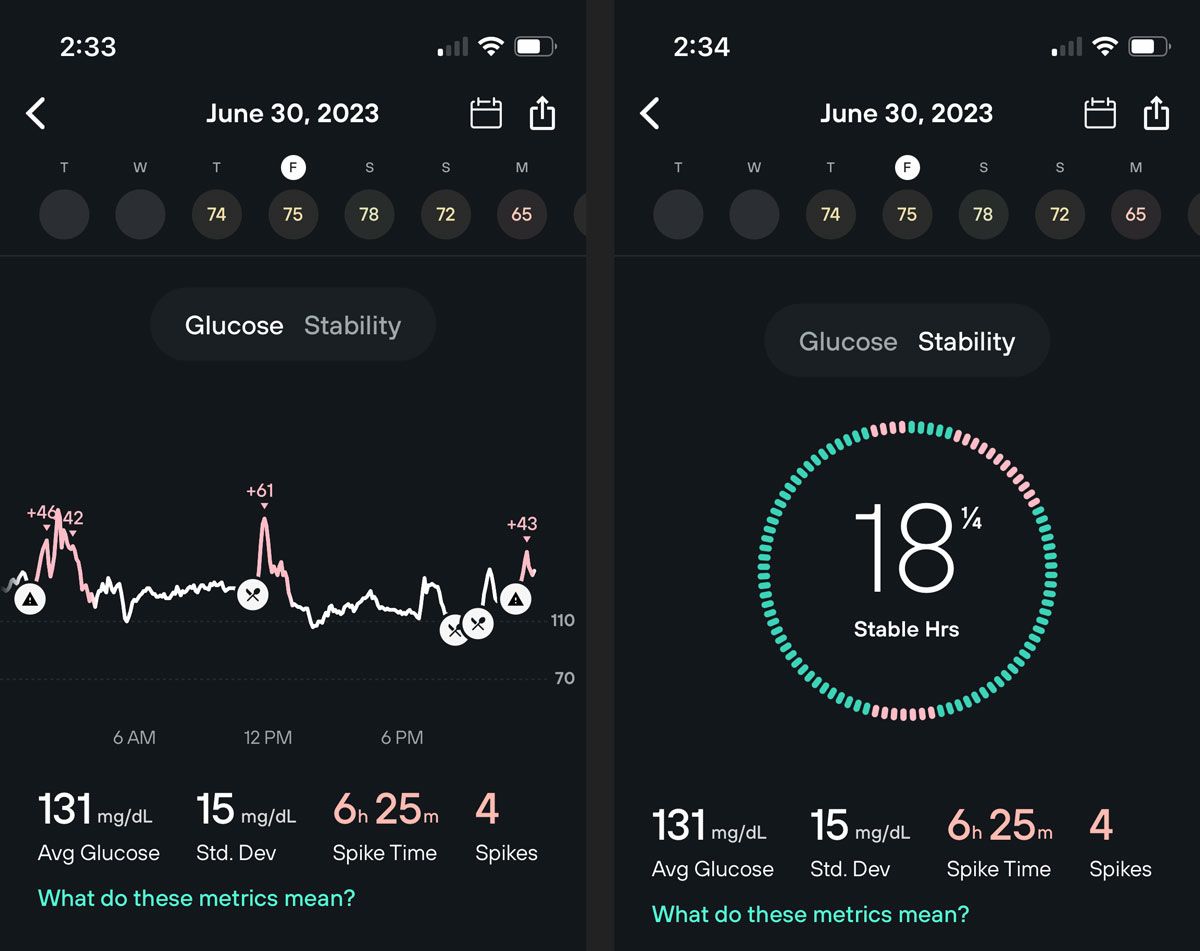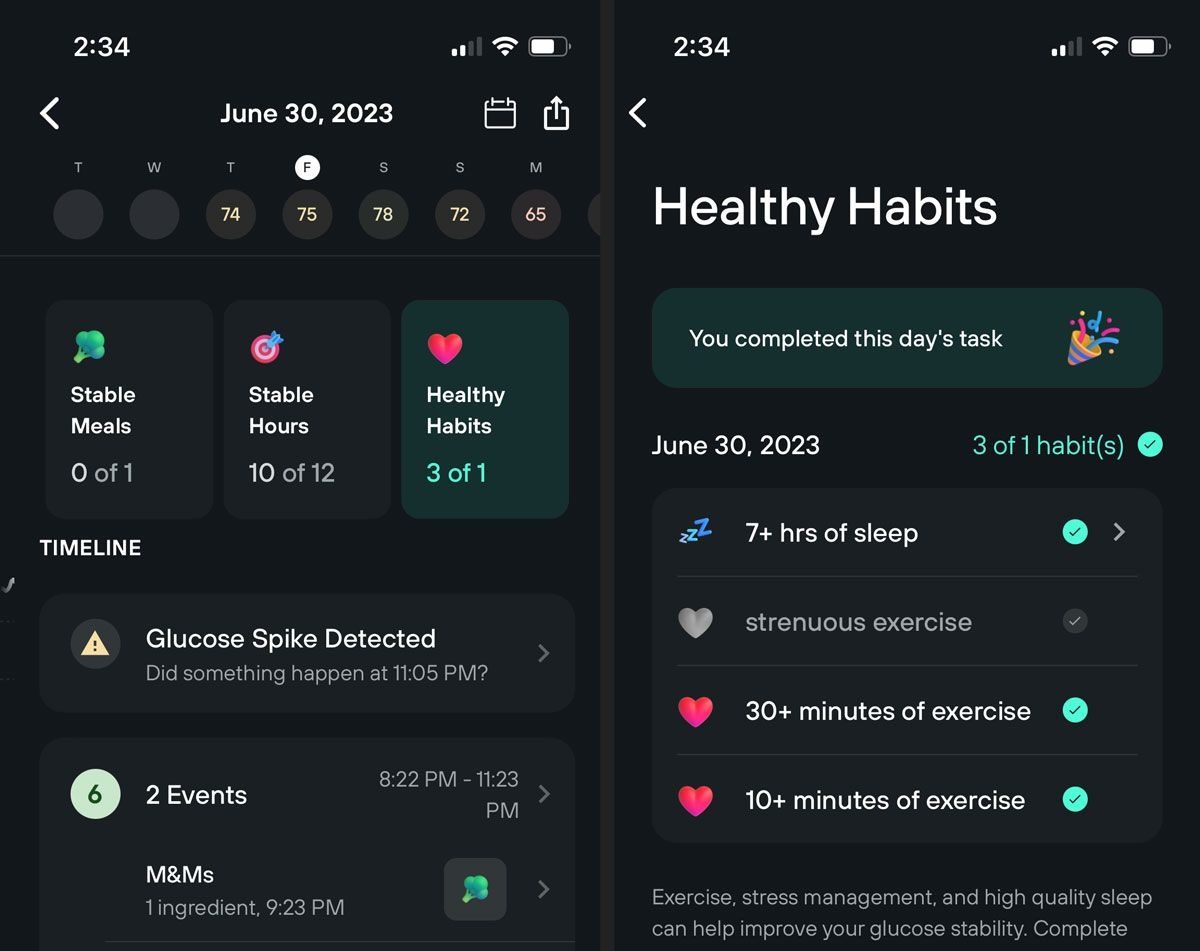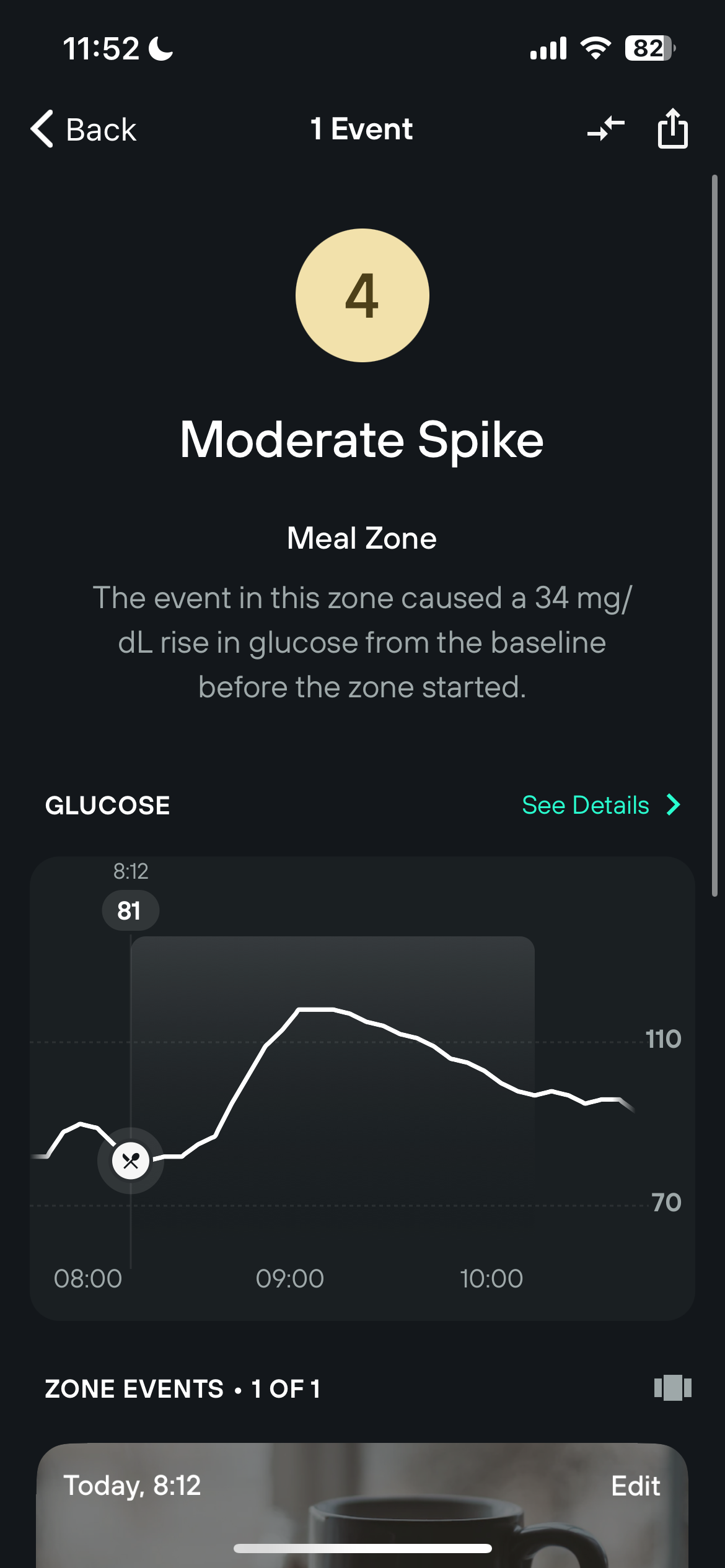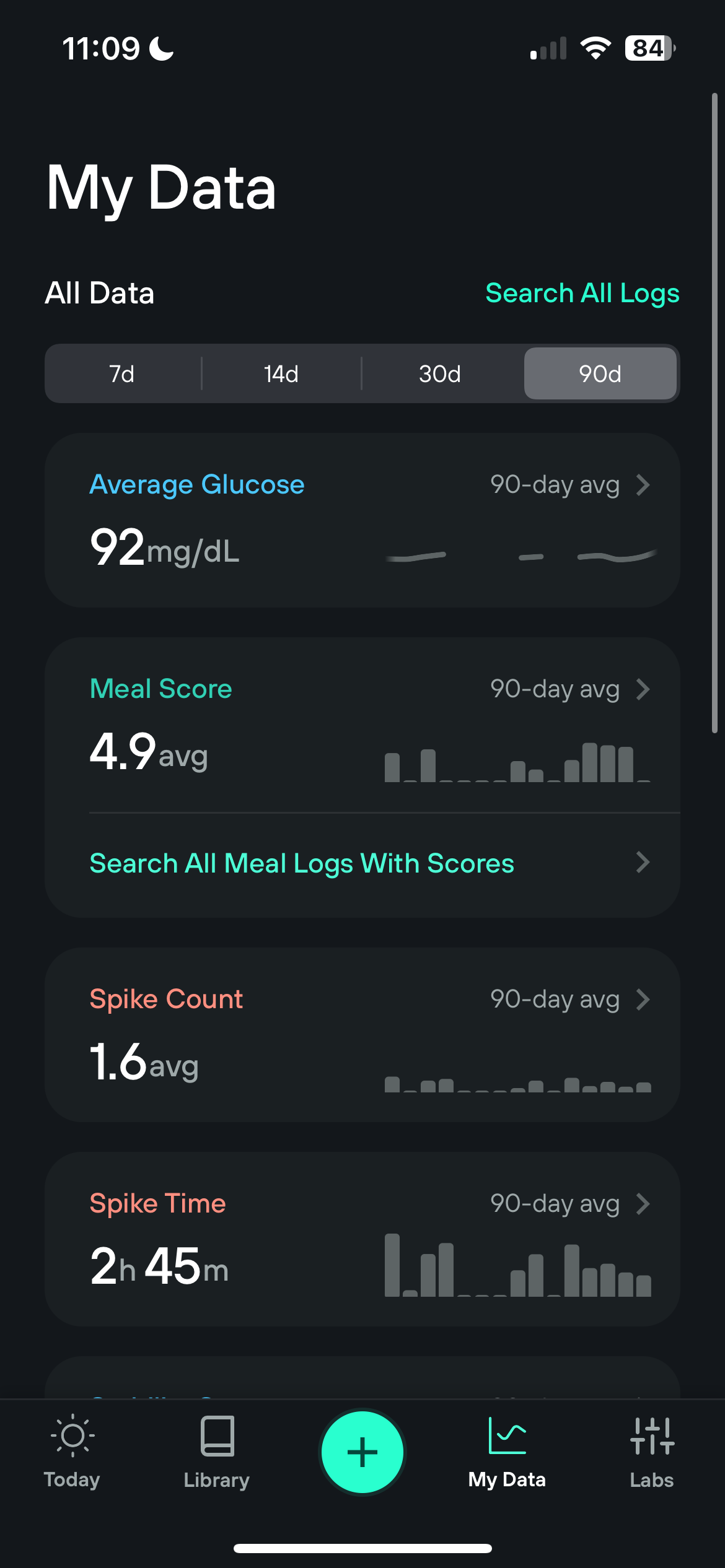
How using Levels can improve your health
Increase your energy and reduce your risk of chronic disease by building healthy, data-informed habits for optimal metabolic health
Levels’ mission is to solve the metabolic health crisis because improving metabolic health is vital to so many other facets of health. It’s ultimately a measure of how our body functions at the cellular level. That affects you right now—how you feel and function—and is the basis for long-term health. A body that can’t process energy efficiently can’t manage processes like inflammation and oxidative stress that contribute to many chronic conditions, from dementia to cancer.
The behaviors that lead to optimal metabolic health aren’t a mystery but can be challenging to maintain. It’s hard to stick to strict diets, especially when you don’t know if those foods are actually helping your body. It’s hard to make yourself get eight hours of sleep a night when tired has become your new normal, and you’re not tracking the consequences.
That’s why monitoring your body in real-time and watching long-term trends—tying health data to behavior—is so life-changing. Once you see your blood sugar shoot up after eating dessert or recognize the reason you’re so exhausted is directly tied to your oatmeal breakfast, motivation to make changes becomes easier. And then you feel the positive effect of those changes. That feedback loop is how sustainable habits get built.
Here are five concrete ways that using Levels to improve your metabolic health can improve your overall health.

Levels shows you your glucose curve and your total time in range for the day.
Levels makes it easier to maintain stable blood sugar
Building habits that stabilize your blood sugar is at the core of optimal metabolic health. When blood sugar is all over the place—spiking and crashing—our body’s systems for dealing with it begin to break down, with short-term and long-term consequences (more on those below).
But several factors influence blood sugar, including diet, exercise, stress, and sleep, so just eating low-carb isn’t enough. That’s why Levels pairs continuous glucose monitoring (CGM) with an optimal glucose range to aim for, so you see what actions (and combinations of actions) produce a response in that stable range.
Levels recommended range is narrower than what’s often considered “normal,” but it’s based on research and input from our expert advisors. The Stability Ring gives you a quick look at how many hours a day you stayed in that range, and you can view specific glucose curves to see what led to excursions outside the range.
And because glucose response is highly individual, Levels’ meal logging and food suggestions help you identify your sneaky spikers and swap them out for better alternatives.
Levels helps you build healthy habits
Most of us know the basic tenets of good health: eat whole foods, exercise daily, get good sleep, reduce stress. The challenge is incorporating those practices into your daily routine in a way that sticks.
The first step is just keeping yourself accountable. That’s why the app has a Daily Checklist that gives you a target of stable glucose hours and meals, as well as exercise and sleep goals (we can import your exercise and sleep data from Apple Health, so you don’t have to log them).
The other key to sustainable habits is a closed-feedback loop. Open feedback loops like nutrition are when you can’t tie outcomes to actions—you eat something you think is healthy, but how do you know? With CGM and an app like Levels, you see the effect of your diet in real-time, so you know that your sushi lunch drove your mid-afternoon slump. Or that the walk after dinner blunted a glucose rise and improved your sleep. Clear-cut data empowers you to dial in habits that produce reliable results, making them easier to maintain.

Levels gives you a daily checklist and shows you how you’ve done today.
Levels can help reduce the risk of chronic disease
Glucose dysfunction plays some role in eight of the top 10 leading causes of death, including diabetes, Alzheimer’s, and COVID-19. Insulin, the hormone impacted by glucose, is behind several other conditions, ranging from heart disease to reproductive health to cancer.
The specific mechanisms tying glucose to those conditions vary widely, but at the most basic level, it comes down to cellular health. Glucose powers every cell in your body, and insulin helps shuttle the glucose into those cells. Both molecules also interact with hundreds of other molecules in your body, like enzymes, proteins, and micronutrients that drive our cellular machinery.
So excess glucose or insulin can throw off any number of processes, but three primary mechanisms lie behind many of the downstream consequences:
- Oxidative stress is when molecules called reactive oxygen species build up and can damage proteins, fats, or nucleic acids (like those found in DNA) and lead to cell death.
- Inflammation is when your body’s natural defense systems go into overdrive. As many as three out of every five deaths worldwide have chronic inflammation as a component.
- Glycation is when sugar molecules “stick” to other molecules and gum up their function. For example, glycation is why high glucose can lead to wrinkles by altering your collagen or atherosclerosis by altering cholesterol.
Maintaining stable blood sugar won’t prevent every disease, but it can reduce your risk by keeping your body in better overall shape.

Levels helps you feel better now
We’ve all felt the consequences of glycemic variability—blood sugar spikes and crashes—even if we didn’t know it. When we eat something high in simple carbohydrates like sugar or refined flour, our body turns those carbs into glucose, and our blood sugar concentration shoots up. This causes a rush of insulin, the hormone that keeps blood sugar stable by removing glucose from the blood. But that abundance of insulin can send our blood sugar temporarily too low—the crash—before stabilizing again.
Both the spike and the crash can affect how you feel in the moment, including:
- Fatigue: Research shows that high and low glucose levels can leave you feeling zapped, and oxidative stress can lead to chronic fatigue.
- Brain fog: Ironically, excess glucose can cause your brain to take up less of it, leaving you lacking focus and clarity.
- Jitters or anxiety: Low blood sugar can trigger your body to release adrenaline. That drives the release of stored glucose to normalize levels but can also leave you feeling anxious or jittery.
- Cravings: Research suggests that a high-carb meal leaves you more hungry in your next meal while cutting carbs reduces cravings in as little as two weeks.
Levels members consistently find that stabilizing their blood sugar improves their energy and mood.
When I was feeling anxious or impatient, having cravings, or my mood was starting to swing, the CGM would confirm that, showing me my blood sugar was dropping. I realized I needed to fuel my body on a much more regular basis with foods aligned with what the sensor was teaching me.—Tika Morgan
Levels helps you focus on the bigger picture

As crucial as stable glucose is, it’s not the only thing that matters for metabolic health. And obsessing over any one lever harms your physical and mental well-being. As Levels co-founder Dr. Casey Means says, “Trends over time are what matters. Your body is remarkably adaptable. It knows how to use hormones like insulin to deal with a glucose spike or antioxidants to fight the damage from a fructose-filled soda.”
That’s why, besides giving you daily feedback you can use as learning moments, the Levels app helps you build long-term habits and track your long-term health across several markers.
The My Data section of the app can show you up to 90-day averages for markers like Spike Time and Waking Glucose, as well as Sleep and Steps.
With our Levels Labs feature, you can order a blood test panel with five key markers tied to metabolic health:
The results appear directly in the app, along with an optimal range informed by our expert advisors and personalized guidance for making improvements. Regular blood testing gives you another opportunity to see the results of your behavior change and know that you’re moving in the right direction.

Take control of your metabolic health
Levels helps you see how food and lifestyle affect your health through macro tracking, habit-building, and customized insights and advice. Levels members can also incorporate biomarker data like real-time glucose and metabolic blood testing for an even more personalized experience. Click here to get started with Levels.




